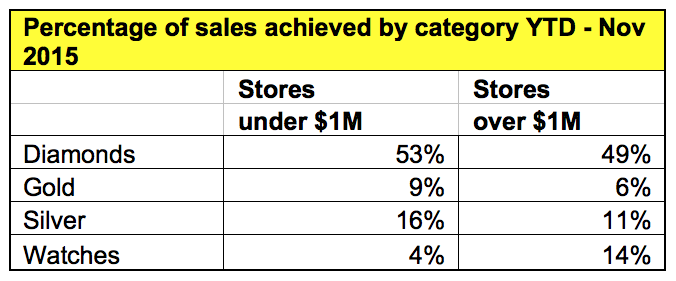November was a month of steady increases in same-store comparative data. November average store sales reached $131,843, up 3.6 percent from last November’s result of $127,255. Within our survey group, the average store’s rolling 12-month sales increased 0.28 percent to $1,618,247 from $1,613,659.
Sales quantities and average retail sale per item were very similar over both years, with just a slight increase of over 1 percent in both. This shows the benefits of small incremental increases however. Even with a drop in margin from 47 percent to 46 percent (rounded) gross profit was up by over 2 percent. If margin had been maintained at 47 percent, it would have resulted in gross profit of $61,966, an increase of 3.5 percent.
This month we compare the respective contribution by department between stores that are achieving under $1 million in sales versus those achieving more. The difference in respective contributions is interesting to see.

We have focused only on the main four departments here: diamonds, gold, silver and watches. The information reflects the percentage contribution from each department over a 12-month period for the respective category of store.
What’s of particular interest in this data is the contribution of jewelry to smaller stores. Diamonds are representing 53 percent of total store sales as opposed to 49 percent for the larger stores. The same is true of gold and silver (9 percent versus 6 percent and 16 percent versus 11 percent). Overall these three categories provide 78 percent of small-store sales versus 66 percent for larger stores. It comes as no surprise that smaller stores do well in silver, which is a lower priced item – the average sale at smaller stores is significantly lower than larger stores; but to see both gold and diamonds being a more significant part of business for smaller stores is a little different to most expectations.
Advertisement
The most noticeable difference is watch sales; 14 percent of larger-store sales versus 4 percent for smaller.
Why the difference?
Let’s look at inventory as the obvious starting point for these numbers. The average large store carries $251,000 of watch inventory, from which they achieve annual sales of $365,000. The average small store carries a watch inventory of $20,952 from which is sales of $24,172 are achieved. As a percentage of overall inventory held, the larger stores carry a total average inventory $2,383,000 so watches represent just over 10 percent of their total stock holding. The smaller stores have $647,000 on average of total inventory so watches represent just under 4 percent of their total inventory holding. There are a lot of factors that can dictate how successful your business is at selling product lines; maintaining a good range of fast-selling product, the training you do, how good your sales staff are with selling those product lines, where the product is located in the store and so on. Ultimately, however, the most important factor is your decision on where you want to be in the game. You can’t win a lottery prize if you don’t have a ticket – and the same is true with sales.
Now you might say this doesn’t matter because you don’t want to sell watches; but that’s not the point here. Whatever area of your business you want to focus on, you need to start with something to show. You need to make a serious commitment to it, and you need to be persistent and consistent. There may be a lot of reasons why watches are a more significant part of a larger-stores sales, but I can tell you that the starting point is having the selection.
You might have the basics covered in terms of your main product categories, but what about the sub categories? What do you want to be known for? Pearls? Colored stone rings? Wedding bands? Within the main areas are the sub categories that you need to decide you are specializing in — and the starting point for each of those in the range you are offering. If you want to be known as a pearl store then what percentage of your selection is in pearls? If wedding bands are your specialty then again, do you have the appropriate percentage of your overall inventory on hand? Begin with this and you are 50 percent of the way to increasing sales.
This article originally appeared in the February 2016 edition of INSTORE.
Advertisement